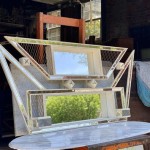Polishing Mild Steel to a Mirror Finish
Polishing mild steel to a mirror finish is a meticulous process that requires patience, precision, and the right tools. It involves removing surface imperfections, such as scratches, burrs, and mill scale, to achieve a highly reflective surface. This technique is often employed in various applications, including automotive parts, jewelry, and industrial machinery, where a polished finish enhances aesthetics, corrosion resistance, and product longevity.
The process of polishing mild steel to a mirror finish can be broken down into several stages. These stages involve progressively finer abrasives to smooth the surface and remove imperfections.
1. Surface Preparation
Before embarking on the polishing process, proper surface preparation is crucial. This initial step aims to remove any loose debris, rust, or contaminants that could hinder the polishing process. It typically involves:
- Cleaning: Thoroughly clean the steel surface using a suitable solvent, such as acetone or isopropyl alcohol, to remove grease, oil, or other residues.
- Deburring: If necessary, remove any sharp edges or burrs using a deburring tool or a fine-grit sandpaper.
- Removing Mill Scale: Mill scale is a layer of iron oxide that forms during the steel manufacturing process. This layer can be removed by a combination of mechanical and chemical methods, such as using a wire brush, grit blasting, or a chemical descaler.
- Leveling: If the steel surface has deep scratches or imperfections, consider leveling the surface using a coarser grit sandpaper or a sanding block.
The goal of surface preparation is to create a clean and relatively smooth surface that is ready for the polishing process.
2. Coarse Grinding
Once the surface is adequately prepared, the polishing process begins with coarse grinding. This stage involves using progressively finer grits of abrasive materials to remove surface irregularities and scratches. Coarse grinding typically uses abrasives ranging from 80 to 240 grit.
Different methods can be employed for coarse grinding, including hand sanding, belt sanding, and using a grinder with a coarse grinding wheel. It is essential to maintain even pressure and control the direction of motion to avoid creating new scratches or uneven surfaces.
3. Fine Grinding
After coarse grinding, fine grinding is performed to further refine the surface and eliminate smaller scratches and imperfections. This stage typically uses finer grits ranging from 320 to 600 grit. Fine grinding can be done with hand sanding, using a finer sanding block, or employing a rotary tool with a fine grinding wheel.
During fine grinding, the focus shifts to achieving a smooth and consistent surface, preparing it for the final stages of polishing.
4. Polishing
The polishing stage involves using progressively finer abrasive materials to achieve a highly reflective finish. This stage typically uses polishing compounds ranging from 1,000 to 12,000 grit. These compounds are often applied with a polishing wheel, felt buff, or a soft cloth.
Polishing can be divided into several stages, each using a finer grit than the previous one:
- Rough Polishing: This stage uses polishing compounds with grits ranging from 1,000 to 3,000 to remove the finer imperfections left behind after fine grinding.
- Medium Polishing: Here, polishing compounds with grits ranging from 4,000 to 8,000 are employed to further refine the surface, improving its smoothness and reflectivity.
- Fine Polishing: This final stage uses polishing compounds with grits ranging from 9,000 to 12,000 to achieve a mirror-like finish. A soft polishing cloth is often used for this stage.
Each polishing stage requires controlled pressure and even motion to ensure a consistent and uniform finish. The final polish determines the final appearance of the steel.
5. Final Inspection and Protection
Once the polishing process is complete, a final inspection is necessary to ensure that the desired mirror finish has been achieved. Any remaining imperfections can be addressed with additional polishing. After inspection, the polished surface should be protected to prevent corrosion and maintain its appearance. This can be achieved with:
- Waxing: Applying a car wax or a similar protective coating helps to create a barrier against moisture and environmental elements.
- Oiling: Applying a light oil, such as mineral oil, can help to prevent rust and maintain the polish's luster.
These protective measures help to preserve the mirror finish and extend the longevity of the polished steel.

Mirror Finish Norton Abrasives

Polishing Metal Mirror Finish Metals Com

How To Polish A Steel Sheet Mirror Finish

How To Polish Stainless Steel Mirror Finish No 8

How To Give Stainless Steel The Right Mirror Finish Thepipingmart Blog

How To Polish A Steel Sheet Mirror Finish

Mirror Finish Norton Abrasives

Mirror Finishing On Stainless Steel Tubes Pipes

Polishing Metal Mirror Finish Metals Com

Types Of Metal Polishing Techniques And Their Polished Step Wayken








